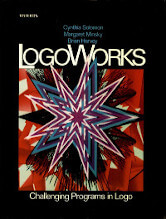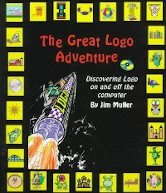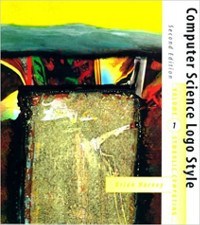Last Updated on April 18, 2024
The Logo Programming Language, a dialect of Lisp, was designed as a tool for learning. It features interactivity, modularity, extensibility, with flexibility of data types.
Logo offers a rich programming environment providing multimedia tools, robotics and network access. Full-featured Logo packages provide hundreds of commands for exploring all sorts of applications, from the simplest turtle graphics to artificial intelligence.
Design and download high-quality logos with this free logo design maker.
None of the books featured below are released under an open source license. There seems to be a dearth of open source programming books for Logo. But the books featured below are available to view without charge.
1. LogoWorks: Challenging Programs in Logo by Cynthia Solomon, Margaret Minsky and Brian Harvey
 This book is targeted at both beginners and advanced Logo programmers who are seeking ideas that go beyond the introductory level.
This book is targeted at both beginners and advanced Logo programmers who are seeking ideas that go beyond the introductory level.
The book demonstrates that Logo is a general-purpose programming language and a powerful tool for thinking.
This is a good book for deepening your knowledge of Logo.
Chapters cover:
- Wordplay.
- Stories.
- Games.
- Turtle Geometry.
- Music.
- Programming Ideas.
- Appendix: Special Features of Atari Logo.
The book has been out of print for a while, but now here it is. The programs are written in Atari Logo by a collection of Logo enthusiasts who hung out at the Atari Cambridge Research Lab. Except for the animation projects most of the programs will run in current versions of Logo.
2. The Great Logo Adventure by Jim Muller
 This book is designed for a beginner programmer. The majority of the book applies to all versions of the language.
This book is designed for a beginner programmer. The majority of the book applies to all versions of the language.
Chapters cover:
- Getting Started.
- Meet the Turtle.
- Making Shapes.
- Writing Procedures.
- Color, Music, and Pizazz.
- Varying Variables.
- Polygons, Circles, Stars, and Stuff.
- Turtle Positions and Coordinates.
- Recursion.
- The Great Math Adventure.
- Animating Multiple Turtles.
- Talk To Your Computer.
3. Computer Science Logo Style Volume 1: Symbolic Computing by Brian Harvey
 This series is for people who are interested in computer programming because it’s fun.
This series is for people who are interested in computer programming because it’s fun.
The three volumes use the Logo programming language as the vehicle for an exploration of computer science from the perspective of symbolic computation and artificial intelligence.
The trick in learning to program, as in any intellectual skill, is to find a balance between theory and practice. This book provides the theory.
Chapters examine:
- Exploration.
- Procedures.
- Variables.
- Predicates.
- Functions of Functions.
- Example: Tic-Tac-Toe.
- Introduction to Recursion.
- Practical Recursion: the Leap of Faith.
- How Recursion Works.
- Turtle Geometry.
- Recursive Operations.
- Example: Playfair Cipher.
- Planning.
- Example: Pitcher Problem Solver.
- Debugging.
Next page: Page 2 – Computer Science Logo Style Volume 2: Advanced Techniques and more books
Pages in this article:
Page 1 – LogoWorks: Challenging Programs in Logo and more books
Page 2 – Computer Science Logo Style Volume 2: Advanced Techniques and more books
All books in this series:
| Free Programming Books | |
|---|---|
| Ada | ALGOL-like programming language, extended from Pascal and other languages |
| Agda | Dependently typed functional language based on intuitionistic Type Theory |
| Arduino | Inexpensive, flexible, open source microcontroller platform |
| Assembly | As close to writing machine code without writing in pure hexadecimal |
| Awk | Versatile language designed for pattern scanning and processing language |
| Bash | Shell and command language; popular both as a shell and a scripting language |
| BASIC | Beginner’s All-purpose Symbolic Instruction Code |
| C | General-purpose, procedural, portable, high-level language |
| C++ | General-purpose, portable, free-form, multi-paradigm language |
| C# | Combines the power and flexibility of C++ with the simplicity of Visual Basic |
| Clojure | Dialect of the Lisp programming language |
| ClojureScript | Compiler for Clojure that targets JavaScript |
| COBOL | Common Business-Oriented Language |
| CoffeeScript | Transcompiles into JavaScript inspired by Ruby, Python and Haskell |
| Coq | Dependently typed language similar to Agda, Idris, F* and others |
| Crystal | General-purpose, concurrent, multi-paradigm, object-oriented language |
| CSS | CSS (Cascading Style Sheets) specifies a web page’s appearance |
| D | General-purpose systems programming language with a C-like syntax |
| Dart | Client-optimized language for fast apps on multiple platforms |
| Dylan | Multi-paradigm language supporting functional and object-oriented coding |
| ECMAScript | Best known as the language embedded in web browsers |
| Eiffel | Object-oriented language designed by Bertrand Meyer |
| Elixir | Relatively new functional language running on the Erlang virtual machine |
| Erlang | General-purpose, concurrent, declarative, functional language |
| F# | Uses functional, imperative, and object-oriented programming methods |
| Factor | Dynamic stack-based programming language |
| Forth | Imperative stack-based programming language |
| Fortran | The first high-level language, using the first compiler |
| Go | Compiled, statically typed programming language |
| Groovy | Powerful, optionally typed and dynamic language |
| Haskell | Standardized, general-purpose, polymorphically, statically typed language |
| HTML | HyperText Markup Language |
| Icon | Wide variety of features for processing and presenting symbolic data |
| J | Array programming language based primarily on APL |
| Java | General-purpose, concurrent, class-based, object-oriented, high-level language |
| JavaScript | Interpreted, prototype-based, scripting language |
| Julia | High-level, high-performance language for technical computing |
| Kotlin | More modern version of Java |
| LabVIEW | Designed to enable domain experts to build power systems quickly |
| LaTeX | Professional document preparation system and document markup language |
| Lisp | Unique features - excellent to study programming constructs |
| Logo | Dialect of Lisp that features interactivity, modularity, extensibility |
| Lua | Designed as an embeddable scripting language |
| Markdown | Plain text formatting syntax designed to be easy-to-read and easy-to-write |
| Objective-C | Object-oriented language that adds Smalltalk-style messaging to C |
| OCaml | The main implementation of the Caml language |
| Pascal | Imperative and procedural language designed in the late 1960s |
| Perl | High-level, general-purpose, interpreted, scripting, dynamic language |
| PHP | PHP has been at the helm of the web for many years |
| PostScript | Interpreted, stack-based and Turing complete language |
| Prolog | A general purpose, declarative, logic programming language |
| PureScript | Small strongly, statically typed language compiling to JavaScript |
| Python | General-purpose, structured, powerful language |
| QML | Hierarchical declarative language for user interface layout - JSON-like syntax |
| R | De facto standard among statisticians and data analysts |
| Racket | General-purpose, object-oriented, multi-paradigm, functional language |
| Raku | Member of the Perl family of programming languages |
| Ruby | General purpose, scripting, structured, flexible, fully object-oriented language |
| Rust | Ideal for systems, embedded, and other performance critical code |
| Scala | Modern, object-functional, multi-paradigm, Java-based language |
| Scheme | A general-purpose, functional language descended from Lisp and Algol |
| Scratch | Visual programming language designed for 8-16 year-old children |
| SQL | Access and manipulate data held in a relational database management system |
| Standard ML | General-purpose functional language characterized as "Lisp with types" |
| Swift | Powerful and intuitive general-purpose programming language |
| Tcl | Dynamic language based on concepts of Lisp, C, and Unix shells |
| TeX | Markup and programming language - create professional quality typeset text |
| TypeScript | Strict syntactical superset of JavaScript adding optional static typing |
| Vala | Object-oriented language, syntactically similar to C# |
| VHDL | Hardware description language used in electronic design automation |
| VimL | Powerful scripting language of the Vim editor |
| XML | Rules for defining semantic tags describing structure ad meaning |
